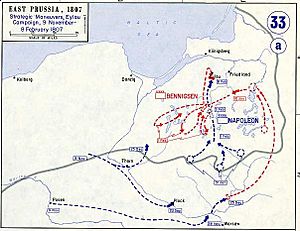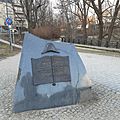Battle of Allenstein facts for kids
- You may also be looking for the 1521 Siege of Allenstein.
Quick facts for kids Battle of Allenstein |
|||||||
|---|---|---|---|---|---|---|---|
| Part of the War of the Fourth Coalition | |||||||
 Battle of Allenstein or Jonkowo. |
|||||||
|
|||||||
| Belligerents | |||||||
| Commanders and leaders | |||||||
| Strength | |||||||
| IV Corps Milhaud's dragoon div. |
Kamensky's division | ||||||
| Casualties and losses | |||||||
| unknown | 800 dead and wounded 300 captured 6 cannon captured |
||||||
The Battle of Allenstein (also called Olsztyn) was a fight during the Napoleonic Wars. It happened on February 3, 1807. This battle was part of the War of the Fourth Coalition. It was fought between the French army, led by Joachim Murat and Jean-de-Dieu Soult, and the Russian army. The battle took place near the town of Allenstein in what was then Kingdom of Prussia. The French won this battle, but it wasn't the big, decisive victory that French Emperor Napoleon was hoping for.
Why the Battle Happened
After defeating the Prussian army in 1806, Napoleon's army, called the Grande Armée, moved east. They wanted to find and fight the Russian army. Winter arrived, and Napoleon thought both armies would stop fighting until spring. He ordered his troops to set up winter camps.
However, the Russian commander, Levin August von Bennigsen, had other plans. He decided to attack the French army's weaker left side. He hoped to surprise them and get behind their main forces.
By chance, a French general named Michel Ney had moved his troops too far forward. He was looking for supplies. His soldiers accidentally ran into the advancing Russian army. This unexpected meeting gave Napoleon a clue about Bennigsen's plan.
Napoleon quickly changed his strategy. He told his left wing to pretend to retreat. This was meant to draw the Russian army further west. Meanwhile, Napoleon moved most of his army north towards Allenstein. His goal was to get around the Russian army and attack them from behind with a much larger force.
But then, something important happened. The Russians managed to capture a secret message. This message was from Napoleon's chief of staff, Louis Alexandre Berthier. It explained Napoleon's entire plan to one of his generals. When Bennigsen read this message, he realized his army was in great danger. He immediately ordered a fast retreat northeast.
The Battle Unfolds
The French army didn't know the Russians were retreating. They continued with Napoleon's original plan. Their lead forces, cavalry led by Joachim Murat and soldiers from Jean-de-Dieu Soult's army corps, moved towards the Alle river.
On February 3, these French troops reached Allenstein. They found part of the retreating Russian army there. Napoleon saw a chance for a big battle. He ordered four more army groups to march to the battlefield. He told Murat to wait for these extra troops before attacking. Once the reinforcements arrived, Napoleon planned for one division to attack the Russians from the front. Soult's troops would then attack the Russians from the side.
On the Russian side, General Nikolay Kamensky had to fight. He couldn't retreat because he needed to protect a very important road and bridges over the Alle river. These were key for the rest of the Russian army to escape safely. The French attack was delayed until about 3:00 PM. This delay gave the Russians time to get ready. When the French finally attacked, the Russians used their fifteen cannons and muskets. They caused many losses for the French soldiers moving forward.
However, the Russian army was defending a narrow passage instead of higher ground. This made it hard for them to hold their position. They slowly had to give up ground under the French attack.
As the afternoon ended, Soult's troops began their attack from the side. After some fierce fighting, they pushed the Russians back across the Alle river. They also captured the important bridge at Bergfriede without it being destroyed. As night fell, the Russian position was in serious trouble. Bennigsen decided to speed up his retreat. He ordered Kamensky to pull his forces out and move to Deppen. Both sides had many casualties. The Russians had to leave behind six cannons and 300 prisoners.
What Happened Next
Even though the French won this battle, Napoleon didn't get the big, decisive victory he wanted. He had to keep chasing the Russians through the cold winter. However, the French did capture the important bridges over the Alle river. The Russians had forgotten to blow them up.
The French continued their chase the next day. They captured sixteen more cannons. The day after, Soult's troops captured 1,200 more Russian prisoners. A series of smaller fights followed. These led to the Battle of Hoff on February 6. Soon after, the Battle of Eylau took place. This was one of the bloodiest battles of the entire Napoleonic Wars.
Images for kids





















